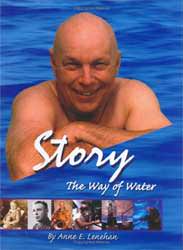
For those unfamiliar with Story Musgrave, a quick list is in order. Story worked at NASA for 30 years. As mission specialist or payload commander for six shuttle flights, he contributed to many scientific endeavours, including the mission to fix the Hubble telescope. While on ground, he kept busy by helping design the EVA suit, being the CapCom for many missions, giving soaring and flight lessons as well as using his medical doctorate at hospitals to perform surgery on patients. With many degrees, he has kept his mind sharp, while with many contributions he has endeavoured to use the knowledge to great benefit.
Continue reading “Book Review: Story – The Way of Water”
Book Review: Deep Space NASA Mission Reports
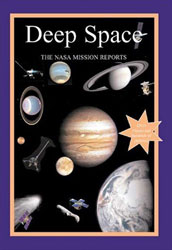
Deep Space – The NASA Mission Reports. Click to enlarge.
With the maturing of space flight in the 1960’s, NASA could set goals loftier than clambering around Earth’s nearest satellite for a few short hours. There existed the ability to travel anywhere in the solar system, take measurements and view the results. Grabbing this opportunity with both hands, NASA launched:
? the Pioneer 10 and 11 crafts on two missions to Jupiter,
? the Voyager 1 and 2 crafts on two missions to Jupiter, Saturn and beyond,
? the Galileo craft on a mission to Jupiter,
? the Cassini-Huygens craft on a mission to Saturn,
? the Deep Space 1 craft on a mission to comet 19P/Borrelly, and
? the Stardust craft on a mission to comet Wild-2.
Nominally each was to expand our knowledge of the solar system and to better understand our relative place within it.
NASA, as typical for all government bureaucracies, dutifully printed up extensive documentation for each mission. From these, the book provides reproductions of press kits, special reports, status reports and fact sheets. The press kits predominate. They describe the craft, the mission, current activities, any extenuating circumstances and expectations just prior to critical moments. Typically, one kit gives a pre-launch summary and others give a summary just before the first encounter of a target. The kits are quite detailed with break downs of the components and functions of each spacecraft. Descriptions of the purpose and equipment for each science experiments clarify the purpose. The trajectory, navigation and communication elements demonstrate some challenges to be overcome. Lists of project managers, principal investigators and contractors ensure posterity to many participants. Thin coverage of the results is an indicator that, though NASA ran the missions and wrote many transcripts, there were others that promulgated the results in their own distinct fashion.
The enclosed DVD shows how NASA has leapt into the new media of video. Audio/video footage from NASA TV and other NASA sources show boosters lofting payloads up and away. During final countdown, often a lengthy time of apparent inactivity, images of trucks and transport aeroplanes delivering components liven up the proceedings. Clean room activities, such as checking solar arrays and mating components, give some insight into preflight activities. Video results of encounters particularly reward viewers. A wonderful segment shows a complete 360 degree coverage of the tumbling asteroid Eros from a very close perspective. Voyager’s visual imagery of the swirling storms on Jupiter transfix the eye and certainly credit the usage of video as a strong communication media.
With the inclusion of all these deep space missions, the editors Godwin and Whitfield provide a marvellous resource for reviewing any deep space mission. Further, by proceeding in a chronological order, the reader can easily grasp how results of an earlier mission influenced the investigations of the following one. From the Pioneer mission, where transit of the asteroid belt came with much misgivings, to Cassini-Huygens dropping a capable probe onto a moon of Saturn, the press kits look the same but the contents just keep getting better.
One thing about having dual missions like Pioneer 10 and 11 or Voyager 1 and 2 is that a lot of similarity exists. The same must be said for their press kits. Though the editors appear to have tried to remove some repetitive verbiage, there are still many tracts, drawings and lists that appear time and again in the book. This is true whether the kits are for different moments of the same mission or of related missions. Also, in keeping with government-eze, just about all the dissertation blandly recites facts and figures. Qualitative descriptors are few and far between. Regarding the DVD, the short 8 page PDF file for Galileo seems an injustice especially considering the 100’s of pages and videos for both Pioneer and Voyager.
One truly rewarding decisions created NASA as a non-military organization. In consequence, they hide little in the quest to learn more about the universe in which we live. The book Deep Space – The NASA Mission Reports as edited by Robert Godwin and Steve Whitfield compiles the very detailed official announcements from NASA for their missions that travelled beyond Mars. In it, facts, figures, data and images corroborate our new awareness and appreciation of our planetary neighbourhood.
Order a copy online from Countdown Creations or Amazon.com.
Review by Mark Mortimer
Book Review: The Real Space Cowboys
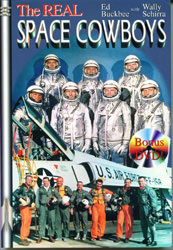
Ed Buckbee started working for NASA in 1959 and was eventually a public affairs officer for the Mercury and other programs. He has kept involved with the United States and international space program. He is also the founder of Space Camp, an educational facility for young want-to-be astronauts. Wally Schirra is one of the original seven astronauts, known as the Mercury Seven. He flew in the Mercury, Gemini and Apollo programs. Given this involvement and their obvious continual passion for space, their book is filled with vivid memories and thoughtful recollections of many of the most well known participants, such as Alan Shepard, John Glenn and Werhner von Braun. Through the judicious use of quotations and well detailed settings, this book brings to life many memorable and probably unknown personal events.
As with any diary, this book journeys down memory lane. The topics flow through chronologically from about the early 1960’s when a squirrel monkey named Miss Baker went into orbit. It ends with taikonauts and the rising stars of Space Camp. Details of bathroom pranks, rocket men in cowboy hats and turtle club antics show an inclination less to factual dissertations and more to the warmer, funny side of things. Most of the writing seems to come from Buckbee’s own experiences. However many quotes, mainly from the Mercury 7 astronauts, bring to life other participants’ feelings regarding space flight, tragedies and hard work. Further, Buckbee has added many photographs of relevant people (and himself) at auspicious occasions. From it all, the message conveys an appreciation of the continual overwork, levity and trepidation that was part of the astronauts’ everyday lives at the forefront of technology.
Separate chapters focus uniquely on each of the Mercury Seven. These principally have direct quotes from those alive or fond remembrances of colleagues since gone. President Kennedy, a recognized driving force for the program, has a chapter that focuses on his involvement. The chapter of Wernher von Braun, the rocket man spirited over from Germany after the end of World War II, highlights his views on travelling to Mars. Most of all though, Alan Shepard’s memories, spirited ‘gotcha’s, and contributions predominate, including a touching memorial to him and his wife Louise. Though not all these people personified the traditional cowboy, they certainly were significant figures in the U.S.’s space program.
Recorded on a DVD attached to the back is a collection of videos. These range from documentaries, to conferences and onto joke films all directly or closely related to the Mercury astronauts. A film clip of Schirra’s ‘roasts’ Shepard after his flight into space. Some rather dry conferences with question and answer periods show astronauts responding to questions from the public. Documentaries, such as the one of Skylab, show the glossy period pieces. Whether for propaganda purposes, advertising or simple stress relief, each film clip adds to the people and events of the book.
The title reference to cowboys presumably acknowledges the typical traits of the astronauts. Or, it is a reference to a picture of Schirra ‘riding’ his Sigma 7 Mercury spacecraft at a museum. Whichever, the book never defines the traits of a cowboy nor how the astronauts had similarities. Nor does the issue of real versus fake appear. Perhaps Buckbee was alluding to the astronauts independence and self confidence which does manifest itself. In addition, the book has the feel of coming from a public relations department. This is not all that bad, as the perspective is unique and close to the action. However, everything has a very positive spin. From this perspective, all the people worked hard, did great deeds and never seemed to have any of the common human failings. Perhaps this is the greatest discrepancy as there are many unpleasantries and failures associated with cowboys of the wild west.
A diary, like this book, is a fun trip down memory lane. The Real Space Cowboys a book by Ed Buckbee with Wally Schirra provides this trip. And coming from the NASA public relations official involved with the program and an astronaut, you can be certain it provides a complimentary, close-in perspective. This together with the many photographs and the included film footage makes travelling this lane a joy.
Read more reviews or order a copy online from Amazon.com
Review by Mark Mortimer
Book Review: Four Astronomy Books for Kids
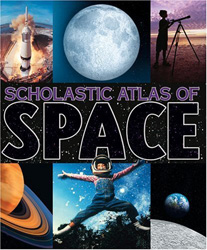
The Planets by Gail Gibbons is a primary level reader. Go outdoors with a youngster and point out the bright red dot of Mars. Then, return indoors and peruse the friendly and accurate portrayal of this planet in the book. For instance, with Mars, there is a diagram that shows its relative orbital position about the sun and a realistic drawing of the Martian globe. There is one diagram per page and underneath each diagram there is some text with relevant facts. Again with Mars, we read how it is the fourth planet from the Sun, about 142 million miles away and two robotic vehicles are exploring its surface. Each of the planets has a two page spread and appropriate factual data.
This book would easily satisfy the bedtime story for the young space buff. A touch of history, a sprinkling of physics and some clever visual representations might instil some knowledge and even awaken that nascent curiosity. For those who are just learning to read, this book will acquaint them with words more challenging than ‘See Spot run’. Further, because of the faithful rendering of the planets, they will knowingly begin to associate traits with names, e.g. the rings belong to Saturn.
Whether you are doing the reading or helping a younger one with theirs, The Planets will start opening up the concept of space and where we are within it.
Admittedly, children grow up way too fast. Primary readers quickly become outdated and children will seek new challenges. The book Stargazer by Ben Morgan is just the solution. Within it are many outdoor and indoor activities to keep a child’s mind turning and their fingers busy.

Within it are more than thirty ways of exploring the skies. Following these will enable youngsters and their elders to happily spend time learning in harmony. Together you can make a planisphere, set up an experiment to check for life and prepare a lunar calendar. These and the other activities will push children into the more abstract thinking associated with the sciences, and at the same time their significance can easily be grasped by an adult so as to relay their deeper meaning.
In keeping with the shorter attention span of the young, the activities are fairly simple and for the most part quick to complete. A two page description is all most have and need. Each has background information, a list of ‘ingredients’ and step by step instructions. For instance, the atmosphere of Jupiter is discussed. Then using simple kitchen items the reader is guided into making patterns of liquids similar to Jupiter’s great red spot. Side comments note the Galileo probe and the Voyager probes that each visited Jupiter.
Stargazer encompasses a broad range of experiments to help a child learn get acquainted with the scientific method and further appreciate the enormity of our universe. In its small format, it is easy to carry and use at club or group meetings while fold-out field guides to the constellations would assist in outdoor discoveries.
In a similar way, Joe Rhatigan and Rain Newcomb in their book Out of This World Astronomy set their own stage for discovery and learning by doing. Within this book are fifty science projects to help grasp the nuances of our solar system, galaxies and even the big bang. With photographs, drawings and sketches, their projects can be accomplished with ease while intertwined related material lets a young reader explore further.
The projects are clearly laid out. A preliminary rationale demonstrates the activity and its relation to the real-life scenario. Again there is a list of required elements and then a step by step guide takes you through the project toward any conclusions. For instance, to grasp the relative distance of the orbits, the reader can head to their nearest football field, place a marker for the sun at one end zone and then use the yard lines to place markers at the appropriate location for each of the planets. Like most of the others, this activity is clear, simple, yet, succinct.

Between the projects, Rhatigan and Newcomb have included many of the mainstays of star watching. The proper use of red lights, how to estimate angles using finger widths, and the construction of the telescope types are all presented. Helpful hints guide the user in finding the planets. Quizzes reinforce the understanding of significant attributes while historical tidbits show the influence the stars have held on generations gone by.
Given the larger format and hardcover, the book Out of This World Astronomy seems better as a static reference. The experiments probably need a bit of planning and the information pages between the experiments are best for a single person sitting down and contemplating. However, the activities are of course more fun with another person or in a group.
The fourth book in this review is a junior level reference work, the Scholastic Atlas of Space. Perhaps the ubiquitous science project is raising its head or your child is asking questions that are beyond your ken. The simple explanations and inviting pictures included within this book will have the two of you happily learning more and getting homework done in no time.
As in keeping with a reference, the book is divided into particular subject matters. Each has background information, relevancy and association. For example under “looking into space” the text discusses the history of observation, broadens the knowledge by discussing the electromagnetic spectrum and then highlights the current top-of-the-heap ability, the Keck telescope on Mount Mauna Kea and the Hubble space telescope.

The subjects extend through the typical space arena. The beginning of the universe, galaxies and formation of stars lead into solar systems. Then, of course, each of our solar system’s planet gets portrayed with their own two page spread of pictures and drawings. The book concludes with a list of facts, star charts for the northern and southern hemisphere, and a helpful glossary.
Though the Scholastic Atlas of Space is a great reference, it really isn’t an atlas. However, one point where it and the Stargazer are well thought out is that they provide units in both metric (i.e. kilometres) and imperial (i.e. miles) values. Out of This World Astronomy give values only in imperial units though it does have a conversion chart in the very back. Nevertheless, all four excel at emphasizing visual imagery rather than text information, a fact alone that sets them apart as being well suited for the young audience.
The stars are free to anyone who wants to view their beauty. Sharing in their twinkling makes their value even greater. So don’t spend too many late nights alone watching the stars spin and rotate about. Use any of the four books described above to easily introduce the wonders of the night skies to young children and together you can expand your horizons.
Review by Mark Mortimer.
Book Review: Atlas: The Ultimate Weapon
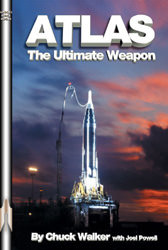
The Atlas booster evolved directly from the melding of experienced German rocket scientists with the need of the United States to counter the USSR’s ability. That is, the United States needed an Intercontinental Ballistic Missile (ICBM). However, as much as the German’s had successfully produced the V2 rocket, there was a huge jump in requirements from the V2 to their needs. For instance, a much heavier payload had to accurately and quickly fly much further over the Earth’s surface and land within a few miles of a given target. And this was to happen within minutes from activation. The Atlas booster was one of the industries’ responses to this government need and this history takes the reader through many of the trials, tribulations and interesting moments that occurred in this evolution of rocket technology.
The goal of the Atlas project was to have a number of active squadrons of ICBMs, ready in an instant to retaliate. Yet, their main goal was to deter an aggressor so they would truly succeed by remaining unused. In a few short years, Convair achieved this goal but the technological advances soon outdated the Atlas booster. Here is where Walker emphasises the beauty of the design as, even with this end point, the Atlas booster went on to perform stellar work in another arena, the space program. Using the tried and true technology of the Atlas booster, men were placed in orbit, cameras were sent to the moon and many global observatories were lofted up. That is, even after launching all the stored Atlas boosters, Convair kept producing these boosters to satisfy general space launch needs.
Using the perspective of a managerial level expert in this industrial program, which he was, Chuck Walker takes the reader on through the concept stage and up to the end of life for the primary mission. His history commences with the state of world affairs that generated a request for proposal by the United States’ Air Force. Convair, an aeroplane manufacturer dabbling in rocketry, won. Walker then uses his own experience within Convair, as well as recollections of many other managers together with saved documentation, to prepare a valid general review.
We read how estimates had to be made for launch site construction even though the missile design was not complete. Materials got stressed to the boundaries of knowledge and beyond. Configuration management, tracking change requests and obtaining appropriate authority ranged from casual recognition during the design stages to almost stifling bureaucracy during installation. Equally, the test and trials start with pure guess work but with experience, processes and procedures ably verified capability and ensured safety. This transformation from novice to proud and knowledgeable initiate resonates throughout the text.
In addition to the actual missile fabrication and deployment, Walker includes many direct contributions from relevant people regarding events and relations with other companies and subcontractors. These views come almost singularly from Convair managerial personnel so there is likely some bias in the perspective. Negligible reference is given to the contributions from subcontractors such as Rocketdyne and its rocket engines or General Electric and its guidance package. Interactions with the customer, that is the United States Air Force, continually crop up to put the pace and level of work into perspective. An overseer company, Ramo-Wooldridge, also has many references as it performed reviews and secondary checks often to the consternation of Convair managers. In all, many personal relationships, well remembered expos?s and a few choice scenarios pleasantly enliven the staid details normally associated with the histories of equipment.
As with any historical review, this book follows a chronological order. However, many particular quotes make the time line seem jumpy. That is, contributor often refer to events discussed in earlier chapters or covered further along in the text. Also, given that Walker refers to the Atlas as a workhorse of the space program, there could have been more information on its usage as such, for example to discuss significant upgrades and accomplishments. Still, there are references for those wishing to explore further.
An Atlas booster put John Glenn into orbit, Surveyor-1 on the Moon and Pioneer-11 to Saturn. But, it began as a critical element in the United States’ policy of deterrence in the early 1960s when rocketry was still in its infancy. The book “Atlas The Ultimate Weapon” by Chuck Walker, with Joel Powell, writes up the history of the development of this weapon and in so doing describes the challenges in mass producing a state of the art ballistic rocket.
Order a copy online from Countdown Creations.
Review by Mark Mortimer.
Book Review: Space Tourism – Adventures in Earth Orbit and Beyond
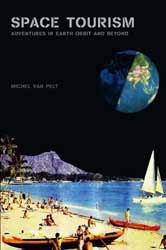
Space tourism seems as obtainable to us as the sun was to Icarus. We struggle to maintain and inhabit a man made structure in the safety of low Earth orbit. Yet, we read about hotels that will allow honeymooners to gaze at the sun setting every 90 minutes. This may be a bit of a stretch, but space tourism can solidly generate revenue for some entrepreneur. As Van Pelt notes, two people have already paid significant amounts, $20 million each, to visit space. Further, as the attraction would easily better any other on planet Earth, all that’s needed is a price low enough. With this, hundreds of people each year would spend their annual vacations in orbit. It is an extreme engineering challenge if there ever was one. Still, from Van Pelt’s perspective, it’s quite obtainable.
Through the book, Van Pelt discusses the technical issues of space flight and pleasant issues of leisure time in space. In a neutral, analytical view, he considers technical issues, starting with the history of space activities, the progressive development of launch vehicles, existing state of the art capabilities and the steps needed to enable the space tourism industry. Practicalities like radiation dosimetres, pressure suits to counter g forces, pre-flight training and group interactions also get attention. These and other technical details are faithfully extended from current or historically established technology. However, launcher reusability is favoured without much supporting justification. Also, some of the later discussion about warp drives, transporters and faster than light travel seem a little out of place and add an incredulous tone to an otherwise rational and even presentation.
Van Pelt has much more fun with the leisure time activities. Using a first person perspective, he places the reader on a three day vacation to an orbiting hotel. The novelty of training, safety lessons and equipment fit-out comes through like any tourist getting ready to embark on some adventurous voyage to the big unknown. Continual comparisons to today’s commercial aeroplane flights enhance the nearness of this opportunity. Further chapters on the launch, ascent and commencement of microgravity quickly distance this trip from any commercial flight. The prose really puts the reader’s feet in the shoes of the starry eyed guest. The descent and landing give the pleasant denouement that would leave the space flyer, and presumably the reader, earnestly desiring another flight. Van Pelt also forays into predicting voyage highlights by imagining sports, games, trysts, and dancing in the realm of microgravity. He ably amplifies how common activities can take on exhilarating dimensions in the confines of a space hotel or on distant surfaces such as the 1/6’th gravity of the moon. There certainly shouldn’t be any lack of fun should his views come to pass.
To aid the reader, the two aspects of the book, the technical and first person view, come in their own chapters. Each follows along logically from the predecessor. For example, first the technical chapter discusses launch vehicles. Then, the first person view places the reader in the eyes of a person as they are launched. Despite these two aspects, the prose remains complimentary, the technical part not being too dry nor the first person view being too qualitative.
As well, the imagination and optimism shown in this book makes for an enjoyable and quick read. Quotes from science fiction writers shows how reality keeps catching up to the earlier imagination of writers from many years ago. Sometimes the optimism gets a bit much though. Van Pelt would have us believe that only a few different decisions at various stages in the United States’ space program would have had people on Mars by now. Also, the discussions about travelling to Mars and further distant planets or stars again raise incredulity rather than support the perceived industry. To build credence and optimism, these parts of the book should have been balanced with more details on means and methods of constructing the infrastructure.
Reality keeps catching up with science fiction. Scientists labour in labs while engineers construct in the field in order to bring the future a little closer to today. However, even they will need to rest and recharge. Michel Van Pelt describes the perfect travel location for recharging in his book, Space Tourism and shows what we need to get there and what may happen once we arrive.
Read more reviews online or purchase a copy from Amazon.com.
Review by Mark Mortimer.
CD Review: Cosmic Fireflies
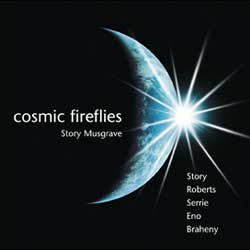
Story Musgrave flew into space six times. His training began in the Apollo era. He was capcom for many flights, including the Skylab missions, and he completed EVA’s, including repairs to Hubble. In total, he has logged over 1281 hours off of Earth’s surface. He certainly has had ample opportunity to reflect upon his circumstances and develop a sense of being space bound. Further, amongst his many accolades he has a master of arts in literature. This combination should remedy the typical astronauts angst at expressing feelings. And it does, as Musgrave, in his disc, portrays a warm, special dimension to space travel.
There are 13 separate tracks on the disc. They alternate between a poem with musical accompaniment and purely musical tracks. Musgrave wrote the poems and does his own recitations. His voice doesn’t have the polish of professional actors, yet enthusiasm and honest feelings are palpably present. And, of course, each of the spoken passages have a direct relation to space.
The first poem presents the ‘rush’ of the rockets launch. An underlying direct feed from an Atlantis launch amplifies the sensation. Another gives a timely and provocative recital of the changing views of Earth seen out the orbiting shuttle’s window. Still another tackles the justification for putting so much natural resources into space exploration. The title piece, Cosmic Fireflies, captures the bedazzlement, like fireworks, that astronauts envision while passing through the Earth’s magnetosphere. Each poem has its own rhythm and sense and each evokes an image or feeling well aligned with space. As a collection, they combine into a journey from the launch, through controlled flight and into the free floating realm that pushes to transcend the pull of gravity and even diminish the continual roar of competition.
The musical style is effectively new age with a touch of techno. Whether in accompaniment or standing alone, each softly encourages reflection and meditation. Perhaps not remarkable on their own, they are nevertheless perfect companions for the poems and add to the emotional journey the listener can travel upon.
This disc would be a perfect addition to an evening spent sitting by a fire and watching the stars. The slow dance of flames would balance with the music and words of the poems. Being outside, under the stars would give credence to the message of humankind’s place on or off planet Earth. However, though the words to the poems are available at the associated web site, it seems a shame that they weren’t included with the disc itself.
As much as people have the power of speech, sometimes we are still left speechless. The wonders of space, perhaps due to their novelty, seem to be well ahead of our descriptive ability. However, Story Musgrave in his compact disc Cosmic FireFlies seeks to redress this situation and the result is a pleasant musical journey and a simple moment for reflecting and pondering.
Visit Story Musgrave’s website at: www.spacestory.com
Listen to samples or purchase a copy of Cosmic Fireflies from Countdown Creations.
Review by Mark Mortimer.
Book Review: The Road to Reality
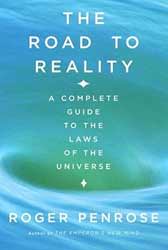
Physics, the study of what we observe, and mathematics, the study of relationships, are intimately intertwined. Often where one goes, the other quickly follows. One may lay the frame work, while the other fleshes out the tone and texture. Roger Penrose, the Emeritus Rouse Ball Professor of Mathematics at Oxford University, has been lecturing since at least the early 1960’s. His passion is twistor theory, an alternative to the contemporary continuous spacetime associated with Einstein’s theory and standard quantum mechanics. Twistor theory and others look to define a grand unifying theory (the math) to combine spacetime, gravity and the probabilistic properties of quanta (the observed).
Penrose in his book, however, doesn’t shove the reader into the deep end of theories without any floatation. Twistor theory, string theory and others reside at the very end. The beginning covers the elemental mathematics. Using qualitative language and expressions such as ‘beautiful’ and ‘elegant’, he relates back to the Greeks and number theory, then on through geometry (similar triangles) and complex numbers (i) to end up with functions. Of course, functions aren’t themselves a destination, they are just a jumping off point for calculus, surfaces, manifolds and spaces. Using all the tricks of the lecturer’s trade, Penrose does an admirable job in delivering knowledge solely from the pages. Diagrams and graphs bring vision to abstract notions of infinite spaces, bundles, n-surfaces and manifolds. Layouts for thought experiments (e.g. photon travel to Titan) convey a simple view to many arguments. Problems sprinkled throughout the book, much like homework assignments, force the reader to delve deeper into certain points of view. And of course, copious references, whether to seminal articles by Newton or recent accounts by today’s researchers, litter the paragraphs and these each trace to expansive notes at the chapter’s end. Given this aid, there certainly is no cause to drown while wading through the complexity of the ideas within.
For yes, the ideas within are complex. Even though no prior knowledge is assumed, some formal training in mathematics or physics would certainly aid the reader. The relative significance and value of Riemann surfaces, conformal mappings and holomorphic functions aren’t readily apparent to the mathematic novice though each has importance. But don’t dismay, for as math is the basis, it isn’t presented for its own sake, rather for its value in contributing to our knowledge of the physics. For example, appropriate math and physics led to the relationship of energy to matter which led to the field of nuclear science. Quantum computing is progressing along the same lines. These are discussed as well as black holes, the dual wave and particle nature of photons, the esoteric nature of gravity and the entropic flow of our universe. For it is the qualities of these elements, such as their reflective or invariant attributes, that must be mirrored in the mathematical relations that model them. Though complex, for those who enjoy this subject, the presentation is invigorating, well paced and thorough.
There is, however, an admitted touch of bias in that Penrose is more contradictory than supportive when it comes to the direction taken by some of today’s researchers. He is certainly not supportive of string theory. He recites many short comings of this as well as his own favourite, twistor theory. Other theories get their comeuppance. In a philosophical section, he goes so far as to contemplate reviewing the current bases for modelling the physics or re-examining the meaning of reality. This is perhaps where the title of the book originates, but still the title seems a bit out of place. The theme of a road never appears in the book, nor is that of reality much included. This book does, however, provide a great mathematical basis for pursuing the investigation of physics. It doesn’t shirk from raising difficulties, dead ends or complete unknowns. With the citations and the progressively more current subject matter, a reader can easily dive in to learn more or maybe to select an area to make their own contribution.
A grand unifying theory is a bit of a holy grail for some mathematicians and physicists. Continual progress is trumpeted through the journals and maybe the theory is just around the next corner. To be prepared for this, or to perhaps consider making your own contribution, read The Road to Reality by Roger Penrose, a smoothly written, finely scoped book showing the contributions that math is making in this and other searches of the physics of nature.
Read more reviews or purchase a copy online from Amazon.com.
Review by Mark Mortimer.
DVD Review: Enterprise Season 1 DVD

Within this seven DVD collection are the 25 shows of the first season, starting with the pilot entitled ‘Broken Bow’ and ending with the season cliff hanger ‘Shockwave Part 1’. Following the final show, special features add insight to the cast and sets. Scott Bakula, the captain and apparent driving force of the show, provides a personal monologue on his views of the casting and thoughts of the early days. A perennial Star Trek guest actor, Vaughn Armstrong (here Admiral Forrest), also waxes a little bit on his times with the genre. Surprisingly, there is little time given for other actors to present their off-stage personalities and perceptions. The Shuttle Pod construction and engine room layout get a greater presence. However, a set of out takes, the now classic addition to any DVD, shows the lighter and more natural side of most of the main characters as they closely worked together in this first season.
Aside from this additional footage, there are optional overlays. Text commentaries by Michael Acadia (Scenic Art Supervisor/Technical Consultant) and Denise Acadia. (Video Supervisor) provide relevant on-screen notes for three episodes. The information regards actors, sets and props, as well as of the Star Trek storyline. The actor notes include previous roles (in and outside Star Trek). Sets and props show the continual transmogrification of equipment for this 18 year old series, particularly as stages and sets moved from Voyager’s realm to Enterprise’s. And, perhaps best of all, the storyline notes link a character or event to other shows of this season or elsewhere in the franchise. Whether interested in some minutia about the set’s background or discussing trivia about the flow of Star Trek history, these overlays make for a pleasant diversion.
Much more rewarding is the audio commentary by the show writers/producers Brannon Braga and Rick Berman which (optionally) plays overtop the dialogue of the season opener. This running commentary, for the duration of the show, explains the rational for the show’s premise, the choice of actors, the process for writing shows and best of all, the scene definition and selection (e.g. the use of computer generation and/or actors). Amongst many other tidbits, Braga and Berman describe how their main objective for this series was character development. Also, continual reference to interweaving today’s functioning technology with perceived novelties from the original series highlights some of their challenges. For example, today’s digital cell phones/cameras provide more functionality in a smaller package than Kirk’s communicators. However, because of the dialogue overlay, the show is unwatchable so, first, watch the season pilot without the audio commentary and then re-watch it with the audio commentary.
Deleted scenes follow eight of the shows. Presumably these (and likely much other footage) were cut as being inappropriate. Yet, by including them as separate segments they are still inappropriate, if not more so. If these were instead part of an optional extended version then they and the DVD collection itself would have had original and noteworthy elements to add interest for regular and new viewers.
The Star Trek Enterprise series went boldly onto a path that many series had gone before. Writers and actors knew that they had to provide something new and entertaining to continue the Star Trek genre. As a prequel, this series does offer a new, refreshing view point. Emphasizing character (and racial) development over exploration and discovery expands on this novelty. On top of the story itself, this DVD collection of Enterprise’s Season 1 contains background information about the plot, filming and actors that helps the initiated and neophyte learn about the path being taken and the difficulties in staying aligned.
A little faith of the heart and you can be dancing amongst the stars. Waiting for that warp drive engine though might be long and depressing so keep your spirits up by enjoying the works of some of Hollywood’s stars. Star Trek Enterprise Season 1 is the 7 DVD set with the 25 shows of the latest and perhaps final installment of the Star Trek, another in the warm tradition of guessing how we might visit other sols and who we might be dancing with when we arrive.
Read more reviews or purchase the DVD set online from Amazon.com.
Review by Mark Mortimer.
Book Review: Light This Candle
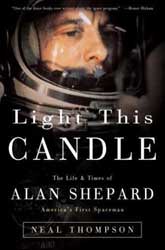
As much he was an astronaut, Alan Shepard was first a military man. Graduating from Annapolis in the closing stages of World War II, he strove to satisfy his addiction to the new fangled flying machines of his youth. Emerging as a carrier pilot then test pilot, he never flew any military missions. Nevertheless, he contributed significantly by evaluating new planes, establishing new flying techniques and extolling the life of the macho flier. Getting to be the ‘best of the best of the best’ wasn’t natural though. Thompson shows us a very troubled beginning. Shepard almost failed out of the Naval Academy, finally graduating, but, closer to the middle than the top of the class. Equally, he nearly got expelled from the navy’s flyer training program at Corpus Christi because of inadequate progress. On review, it is certainly apparent that Alan Shepard was much more a self-driven person than a natural. With a goal in target, he’d exert all his physical, emotional and sometimes devious energy to succeed, but he didn’t seem to always have a goal.
Yet, time and again Thompson shows Shepard’s determination. Descriptions of his youth show a person pushed to achieve his goals rather than receive them on a platter. Needing a bicycle to make regular visits to an airport, his parents gave him chickens to produce eggs and sell. Needing to satisfy his ambition to fly after getting medically grounded, he found a novel surgical technique to remedy his symptoms of M?ni?res’s disease. Don’t get the idea that Shepard was superhuman. Continual references show a hard drinking, womanizing, Type A personality confronting peers and superiors. Frequent instances of flat hatting demonstrate a consideration of rules as more guidelines than limits. Thompson ably shows these and the many superlatives of Shepard’s life in the event filled times in which he lived.
And as the title suggests, Thompson has an equally admirable ability to depict those times. World War II, Pearl Harbour and Okinawa stress the trials of Shepard’s pre-flight days in the navy. Background descriptions of Corsairs, landing signal officers (LSO) and night time carrier landings surround Shepard in his initiation to naval flight. Vilifications of NASA’s early days arise when engineering knowledge was slightly trailing the science and often barely a half step ahead of training. Shepard’s endeavours to sell scrub and swamp land to unknowing home buyers bring to mind catch phrases about salesmen of yor. Keep in mind that Shepard’s Redstone flight was about 15 minutes and his Apollo14 flight about 7 days, so this book, as with Shepard’s life, includes much, much more than the usual public portrayal of one of the early astronauts in the United States’ space program.
Also peppered throughout the book are references to many luminaries and dignitaries. Descriptions and undertakings of the Mercury Seven abound. Kings and queens, presidents and politicians enter and travel along with Shepard in his lifetime. Golf stories with fellow duffers and pros abound, while social evenings with dignitaries and Hollywood socialites allude to the intermingling amongst the famous. Though with fame of course comes the down side as Thompson shows how Shepard was as often a puppet for the government as a strongman propped up for the public. This unveiled view exemplifies the humanness of even this exemplary person.
A good biography places the reader like a shadow beside the subject to fabricate an image of the life and personality. Thompson does an eloquent and effective job in this with a well researched and well referenced perspective of Allan Shepard’s life and times. Though the writer’s largess might perhaps provide a bit too descriptive a narrative at times, there is no doubt as to the his take on how Shepard lived and effected the life and times of people throughout the world.
What makes a perfect astronaut? Selecting who has the right stuff to fly in space would challenge any selection process. Yet, every person is unique; imperfections and flaws blend with natural ability and desire. Alan Shepard, the second person in space and great contributor to the United States space program, had the fortune and aptitude to walk on the moon and live a very gifted and at times harrowing life. Neal Thompson presents a smooth, richly endowed biography of Shepard’s life in his book Light This Candle and through a great story, show’s that an imperfect person can become a perfect astronaut.
Read more reviews, or purchase a copy online from Amazon.com.
Review by Mark Mortimer.
